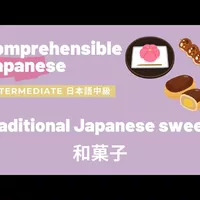Traditional Japanese Sweets 和菓子 🍡 - Intermediate Japanese 日本 語 中級
こんにちは 今日 の 動画 の テーマ は 和菓子 です
和菓子 です
日本 に 昔 から ある お 菓子 の こと を 和菓子 と いいます
逆に 海外 、特に 西洋 から 日本 に 入って きた お 菓子 の こと は 洋菓子 と いいます
例えば ケーキ と か シュー クリーム と か
クッキー と か こういった お 菓子 は 洋菓子 です ね
皆さん 和菓子 を 食べた こと は あります か 和菓子 好きです か
私 は 昔 、子供 の 頃 は あんまり 好きじゃ ありません でした
和菓子って いう と お じいちゃん おばあ ちゃん が 食べる もの と いう イメージ でした
子供 の 頃 は 和菓子 より も 洋菓子 の ほう が 好きでした
和菓子 より も 洋菓子 を よく 食べて いました でも 大人 に なって から は
和菓子 も 洋菓子 も 両方 と も 好きに なりました
今 は 両方 と も 同じ くらい 好きです 今日 は 皆さん に 代表 的な 和菓子 を いくつか
紹介 したい と 思います まずは これ 、大 福 です
大 福 と いう の は あんこ を 餅 で 包んだ 食べ物 です
餅 の 中 に あんこ が 入って います あんこって 何 か 知っています か
あんこ と いう の は この 中 に 入って いる 茶色い もの の こと な ん です けど
小豆 と いう 豆 を
柔らかく なる まで 鍋 で 茹でて
砂糖 で 甘く 味付け した もの です この 中 の あんこ は とって も 甘い です
あんこ に も 2種類 あって 小豆 の
この 豆 の つぶ つぶ が 残って いる 粒 あん と つぶ つぶ が ない
こしあん この 2種類 が あります
大 福 に も 色 んな 種類 が あります よ 外側 の 餅 に 豆 を 入れた
豆 大 福 や 餅 の 部分 に この よもぎ と いう 葉っぱ を
練り込んだ よもぎ 大 福
それ から 苺 を 入れた いちご 大 福 など が 有名です
私 が 一 番 好きな の は いちご 大 福 です
あんこ の 甘 さ と 苺 の 甘 酸っぱ さ が よく 合って とっても おいしい です よ
次に 紹介 する 和菓子 は 団子 です お 団子 です
団子 は お 米 など を 粉 に した もの と 水 を 混ぜて
丸く して 茹でたり 蒸したり した もの です
こんな 風 に 串 に 刺さった 団子 は 串 団子 と いいます
これ は ピンク と 白 と 黄緑 の 3色 団子 です 他 に も 色 んな 種類 の 串 団子 が あります
この 写真 に は 3種類 の 串 団子 が 写って います ね
一 番 左 は 多分 黒 ごま の 団子 です ね 黒 ごま これ です これ が 黒 ごま です
黒 ごま を ペースト 状 に した もの が かかってます ね 真ん中 は みた らし 団子 です
醤油 と 砂糖 で 作った 甘い タレ が かかって います
みた らし 団子 と いいます 一 番 右 は こしあん の お 団子 です ね
皆さん だったら どれ を 食べて みたいです か 私 は この 中 だったら
こしあん の お 団子 が 一 番 好きです これ は 皆さん 知っています か
これ は どら 焼き と いいます この上 と 下 の 茶色い 部分 は
柔らかくて 甘い 生地 です 柔らかくて 甘い 生地 に
あんこ が 挟まって います どら 焼き と いいます これ 実は ある アニメ の キャラクター の
大 好物 な ん です よ 誰 の 大 好物 だ と 思います か
正解 は ドラ え もん です ドラ え もん は どら 焼き が 大好きな ん です よ
こんな 風 に 中 に 栗 が 入った もの も あります
これ は 何 でしょう これ はたい焼き と いいます
鯛 と いう の は 魚 の 名前 です
鯛 の 形 を した 生地 の 中 に あんこ が 入って います
たくさん 入って います ね
あんこ が ぎっしり 詰まって います あんこ だけ じゃ なくて カスタードクリーム や
チョコレート クリーム が 入った もの も あります よ
これ は 饅頭 です 饅頭 は
小麦粉 など を 使って 作った 生地 の 中 に あんこ など を 入れて
蒸した もの です 丸くて 見た目 は
大 福 と 似て います よ ね でも 大 福 の 外側 は
餅 で できて いる ので 大 福 の 方 が モチモチ して います
饅頭 に も いろんな 種類 が あります
あと は こういう の も 和菓子 の 一種 です ね これ は 煎餅 です
煎餅 も を お 米 の 粉 から できて いる ん です けど
煎餅 は 茹でたり 蒸したり する んじゃ なくて
こう やって 焼いて 作ります これ は わらび 餅 と いいます
これ は ゼリー みたいに プルプル して います プルプル した 食 感 です
こんな 風 に きなこ を かけて 食べます きなこ と いう の は 大豆 と いう 豆 から
できた 粉 です これ は 羊羹 と いいます
私 は さっき 子供 の 頃 は 和菓子 は あまり 好きじゃ なかった けど
大人 に なって 好きに なった と 言いました よ ね そう 言った ん です けど
羊羹 だけ は 未 だに あんまり 好きじゃ ないで す あと は 皆さん
こんな 綺麗な 和菓子 を 見た こと は あります か
季節 ごと の 花 など を モチーフ に して 作った 和菓子 です
すごく 綺麗です よ ね 食べる の が もったいない くらい 綺麗です ね
食べ ず に
とって おきたい くらい 綺麗です 今日 は 色々な 和菓子 を 紹介 しました
皆さん は どの 和菓子 を 食べて みたいです か 和菓子 の 話 を して いたら
お腹 が 空いて きました 今日 は これ で
おしまい
また ね

